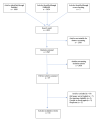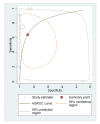Is Ultrasound a Reliable and Reproducible Method for Assessing Adnexal Masses in Pregnancy? A Systematic Review
- PMID: 34849310
- PMCID: PMC8622077
- DOI: 10.7759/cureus.19079
Is Ultrasound a Reliable and Reproducible Method for Assessing Adnexal Masses in Pregnancy? A Systematic Review
Abstract
In this study, we aimed to systematicallyreview the current evidence regarding the diagnostic accuracy of ultrasound in assessing adnexal masses in pregnancy. The Cochrane Register of Controlled Trials, PubMed, and EMBASE databases were searched for all types of clinical studies that utilised ultrasound for the diagnosis of adnexal masses in pregnancy. Only studies that used outcome measures of either histological diagnosis or significant regression of the adnexal mass on imaging follow-up were included. The quality of each study was assessed for risk of bias. The diagnostic performance of ultrasound in each study type was calculated, along with the pooled diagnostic performance of ultrasound in differentiating benign from malignant masses. The initial search yielded 4,915 articles, of which 2,547 qualified for abstract screening. A total of 83 articles were included in this review, including one prospective cohort study, six retrospective observational studies, seven case series, and 69 case reports. In the included studies, the total number of adnexal masses was 559. The mean patient age was 29.2 years (95% confidence interval [CI]: 28.7-29.7), with a mean gestational age at diagnosis of 13.8 weeks (95% CI: 13.2-14.4). The mean quality assessment score was 75%. The International Ovarian Tumour Analysis Simple Rules were used in two articles, whereas subjective impression was used in the remaining 81 articles. The most frequently diagnosed mass was a simple or physiological cyst (35%). The prevalence of malignancy in the entire sample was 46/559 (8%; 95% CI: 34-61%). The overall pooled sensitivity, specificity, positive likelihood ratio, and negative likelihood ratio of ultrasound in detecting ovarian malignancy were 64% (95% CI: 30-88%), 88% (95% CI: 64-97%), 5.6 (95% CI: 1.2-25.4), and 0.4 (95% CI: 0.15-1), respectively. In conclusion, currently, there is a lack of high-quality prospective studies to guide the management of adnexal masses in pregnancy. Ultrasound appears to have an adequate accuracy in differentiating benign from malignant masses; however, more research is required to assess the role of ultrasound models, rules, and subjective assessment in pregnancy compared to non-pregnant women.
Keywords: adnexal mass; diagnostics; ovarian neoplasm; pregnancy; ultrasonography.
Copyright © 2021, Gaughran et al.
Conflict of interest statement
The authors have declared that no competing interests exist.
Figures
Similar articles
-
Simple ultrasound rules to distinguish between benign and malignant adnexal masses before surgery: prospective validation by IOTA group.BMJ. 2010 Dec 14;341:c6839. doi: 10.1136/bmj.c6839. BMJ. 2010. PMID: 21156740 Free PMC article.
-
Prospective external validation of IOTA three-step strategy for characterizing and classifying adnexal masses and retrospective assessment of alternative two-step strategy using simple-rules risk.Ultrasound Obstet Gynecol. 2019 May;53(5):693-700. doi: 10.1002/uog.20163. Ultrasound Obstet Gynecol. 2019. PMID: 30353585
-
Ovarian Adnexal Reporting Data System (O-RADS) for Classifying Adnexal Masses: A Systematic Review and Meta-Analysis.Cancers (Basel). 2022 Jun 27;14(13):3151. doi: 10.3390/cancers14133151. Cancers (Basel). 2022. PMID: 35804924 Free PMC article. Review.
-
External validation of IOTA simple descriptors and simple rules for classifying adnexal masses.Ultrasound Obstet Gynecol. 2016 Sep;48(3):397-402. doi: 10.1002/uog.15854. Ultrasound Obstet Gynecol. 2016. PMID: 26748432
-
Guideline No. 403: Initial Investigation and Management of Adnexal Masses.J Obstet Gynaecol Can. 2020 Aug;42(8):1021-1029.e3. doi: 10.1016/j.jogc.2019.08.044. J Obstet Gynaecol Can. 2020. PMID: 32736853 Review.
Cited by
-
Struma Ovarii during Pregnancy.Diagnostics (Basel). 2024 Jun 1;14(11):1172. doi: 10.3390/diagnostics14111172. Diagnostics (Basel). 2024. PMID: 38893698 Free PMC article. Review.
-
Adnexal Torsion in the Third Trimester.Cureus. 2024 May 22;16(5):e60836. doi: 10.7759/cureus.60836. eCollection 2024 May. Cureus. 2024. PMID: 38910722 Free PMC article.
-
Adnexal Masses in Pregnancy: A Single-Centre Prospective Observational Cohort Study.Diagnostics (Basel). 2024 Sep 30;14(19):2182. doi: 10.3390/diagnostics14192182. Diagnostics (Basel). 2024. PMID: 39410586 Free PMC article.
-
Point-of-care ultrasound in the management of shock: what is the optimal prescription?Can J Anaesth. 2022 Feb;69(2):187-191. doi: 10.1007/s12630-021-02151-7. Epub 2021 Nov 24. Can J Anaesth. 2022. PMID: 34820765 English. No abstract available.
-
Clinicopathological Profile and Obstetric Outcome of Pregnant Women with Persistent Adnexal Masses.J Obstet Gynaecol India. 2025 Apr;75(Suppl 1):227-234. doi: 10.1007/s13224-024-02091-4. Epub 2025 Jan 3. J Obstet Gynaecol India. 2025. PMID: 40390953
References
-
- The management of ovarian pathology in pregnancy. Bignardi T, Condous G. Best Pract Res Clin Obstet Gynaecol. 2009;23:539–548. - PubMed
-
- Management of adnexal masses in pregnancy. Alalade AO, Maraj H. Obstet Gynecol. 2017;19:317–325.
-
- The risk of adverse pregnancy outcomes following nonobstetric surgery during pregnancy: estimates from a retrospective cohort study of 6.5 million pregnancies. Balinskaite V, Bottle A, Sodhi V, Rivers A, Bennett PR, Brett SJ, Aylin P. Ann Surg. 2017;266:260–266. - PubMed
-
- Ovarian endometriosis during pregnancy: a series of 53 endometriomas. Bailleux M, Bernard JP, Benachi A, Deffieux X. Eur J Obstet Gynecol Reprod Biol. 2017;209:100–104. - PubMed
-
- Changes seen in the ultrasound features of a presumed decidualised ovarian endometrioma mimicking malignancy. Sayasneh A, Naji O, Abdallah Y, Stalder C, Bourne T. J Obstet Gynaecol. 2012;32:807–811. - PubMed
Publication types
LinkOut - more resources
Full Text Sources


